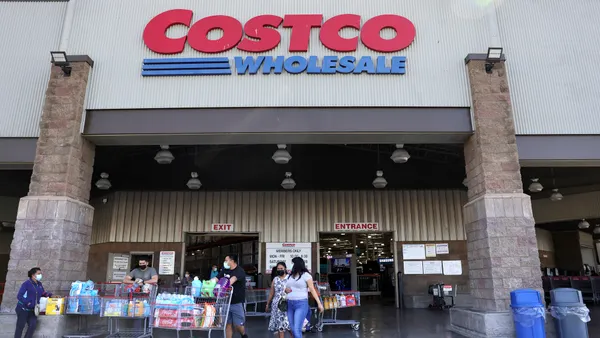The sourcing function of the retail enterprise is about much more than selecting vendors and suppliers and managing those relationships. It’s also about realizing value for the business by optimizing cost savings, enforcing compliance, ensuring a diverse supplier mix, and saving valuable time throughout the source-to-contract process.
Jo-Ann Stores — a specialty chain retailer of crafts and fabrics with about 860 stores in the U.S. — goes so far as to refer to its Procurement arm as the ‘Value Realization’ function of the business.
“Our CEO Wade Miquelon was very passionate about standing up a strategic sourcing procurement function that ensured process improvement as priority,” said Sarah Wright, Director of Value Realization for Jo-Ann Stores.
“From a day-to-day perspective, I work with my team to make sure that we have the right strategies set up for each category, and I manage and mitigate any risks — whether it be a supply risk, a cost risk, anything from that standpoint,” adds Wright. “Then I drive those strategies through our enterprise projects and RFPs.”
For sourcing teams like Jo-Ann’s teams to realize value through those enterprise projects, they need to move fast when it comes to managing and collaborating on RFPs and contracts. Enterprises today are not only racing to drive transformation and meet savings targets after a challenging year; they’re also looking to move from reactive to proactive strategies.
“We've seen huge breaks in the supply chain over the past year,” said Wright. “Being able to trace our suppliers, to know what their supply chains look like and understand where our risks and our constraints are, will help us be able to be more predictive about that as opposed to reactive. We want to learn from what happened [last year] and incorporate that appropriately.”
Yet despite the growing strategic significance of sourcing, many enterprises still rely on manual workflows and legacy tools for sourcing, contracts, and supplier engagement.
“Procurement and sourcing are such impactful parts of an organization,” said Stan Garber, Vice President of Spend GTM at Workday. “But a vast majority of companies’ strategic sourcing teams find themselves managing sourcing projects, savings, justifications, requests from the business, contracts and supplier data all in siloed places that are not talking to each other in any way.”
“It's often email, Excel and SharePoint,” Garber added, “and the impact of that is just a lot of wasted time and loss of data.”
Only with an effective supplier-engagement strategy, and the right strategic sourcing toolset, can a retail enterprise realize the full effect of its vendor-supplier relationships. But unfortunately, a lot of sourcing and contract-management solutions have low adoption rates.
“A lot of what’s out there is unusable or hard-to-use software,” Garber said. “Organizations buy it, but no one wants to use it — so it becomes shelfware very quickly.”
Ultimately, no “shelfware” can rise to the needs of the evolving procurement function. To do that, enterprises need flexible, adaptable, easy-to-use solutions that minimize manual processes and make collaboration easier.
“Innovation comes from being able to work together in a streamlined way,” said Garber. “Step one is having collaboration tools and data in one place.”
“That ultimately will allow for efficiencies, which will allow the sourcing team to spend more time on the business goals and objectives versus the little tactical things that they need to do day in and day out,” said Garber. “You can automate a lot of the little things that take up a lot of time — such as following up with suppliers, making sure they have their forms, making sure they've certified, making sure they submitted their bid, and so on.”
Using nimble, best-of-breed solutions also helps enterprises derive quick ROI. Enterprises can not only collaborate more easily with suppliers and facilitate team evaluations for bid responses, for example, but can also leverage tools and features (such as fact-based negotiations and reverse auctions) designed to drive savings.
“We've seen one reverse auction pay for our platform fee in magnitudes,” said Garber. “Millions or hundreds of thousands of dollars can be saved, if the category is meaty enough, and these [reverse auctions] are things you can operationalize within weeks of signing the agreement.”
Reverse auctions aren’t the only way to save money, either. Leveraging a modern solution like Workday enables teams to manage, prioritize, and track all sourcing projects in one place to tie sourcing activities to business impact. The more projects enterprises engage in, the more value they realize.
“Our stakeholders used to kind of view RFP as a dreaded word,” said Wright. “But with Workday, we’ve been able to put templates in place for a simple drag-and-drop process — we can load the specifics and get the RFP launched quickly with minimum input from stakeholders, which they really appreciate. So we’re able to do more RFPs and get them done faster.”
Adding contract-management functionality into your sourcing solution accelerates the advantages. At Jo-Ann, for example, “contracting volume has increased 200% over the last year,” Wright said. But because of the ease-of-use and scalability of the Workday Contracts application — which enables enterprises to gain visibility and control over approvals throughout the end-to-end contracting process — Jo-Ann has been able to “handle that volume with the same headcount with 50% faster turnaround time.”
It all comes down to realizing value through a strategic sourcing toolset that’s easy to use, and makes collaboration (and innovation) easier.
“This is software for the enterprise that is easy to buy, adopt, and love,” Garber said.
Learn more about how Workday Strategic Sourcing streamlines the source-to-contract process here.










